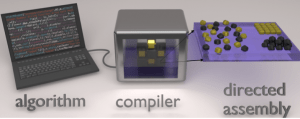 The confluence of recent advances in the programmable synthesis of nanostructured materials and additive three-dimensional (3D) manufacturing have opened up an incredibly rich opportunity space for innovation. Prototype nanomaterial-based technologies have advanced tremendously as evidenced by impressive progress in a broad range of applications spanning sensors, membranes, catalysis, magnetic data storage, electronics, displays, photodetectors, photovoltaics, energy storage, thermoelectrics, and more. Yet, along with rising expectations, there is growing recognition that sustained progress towards the acclaimed promise of nanomaterial-enabled technologies depends critically on solving outstanding fabrication challenges; in particular the need to bridge the length-scale gap between millimeter scale devices and nanometer scale components. We embrace this challenge as an opportunity to integrate control over individual nanostructures (at atomistic length scales), programmable molecular assembly of micrometer superstructures and advanced manufacturing methods (spanning micrometer to meter) as schematically illustrated in the Figure below.
The confluence of recent advances in the programmable synthesis of nanostructured materials and additive three-dimensional (3D) manufacturing have opened up an incredibly rich opportunity space for innovation. Prototype nanomaterial-based technologies have advanced tremendously as evidenced by impressive progress in a broad range of applications spanning sensors, membranes, catalysis, magnetic data storage, electronics, displays, photodetectors, photovoltaics, energy storage, thermoelectrics, and more. Yet, along with rising expectations, there is growing recognition that sustained progress towards the acclaimed promise of nanomaterial-enabled technologies depends critically on solving outstanding fabrication challenges; in particular the need to bridge the length-scale gap between millimeter scale devices and nanometer scale components. We embrace this challenge as an opportunity to integrate control over individual nanostructures (at atomistic length scales), programmable molecular assembly of micrometer superstructures and advanced manufacturing methods (spanning micrometer to meter) as schematically illustrated in the Figure below.
Our vision for integrating molecular self-assembly and 3D printing is inspired, in part, by sci-fi concepts like the ‘matter compiler’ introduced Neil Stephenson’s book ‘The Diamond Age’. Consider an arbitrary 3D shape and now imagine using a computational algorithm to encode that structure into a set of molecular assembly instructions which are ultimately printed in the compiler. Although this might sound like science fiction, fascinating recent breakthroughs in DNA origami have successfully demonstrated that this programmable approach to molecular assembly is possible now. We are excited about the prospects of extending this fabrication approach beyond DNA-based materials to include nanostructured inorganic building blocks (e.g. semiconductors, metals) which leads to compelling prospects for meta materials and devices with programmable optical and electronic properties.

Our first steps in this endeavor have focused on establishing the fundamental understanding of the processing-structure relationships of 3D printing with inorganic building blocks. For example, we showed that oxozirconium clusters can be 3D printed to create hierarchical mesoporous materials with direct application in chemical separation technologies[]. In collaboration with the Wiesner group[], we also demonstrated how small (10nm) silica cages can be printed to create complex porous structures. Notably, this fabrication approach can leverage the versatile cage chemistry modifications to create programmable chemical functionalities throughout the 3D object. A key innovation that emerged from this approach is an internal printing strategy which enables the localized deposition of a guest material within a 3D printed host matrix. Another important recent step in our journey towards developing a nano compiler is the integration of interfacial self assembly and photolothographic patterning. We recently demonstrated that this approach works to define the structure and position of self assembled superstructures in plane. Moving forward, we are excited about the opportunities to combine insights from these recent advances to create programmable materials and devices inspired by our concurrent efforts in energy related technologies.

